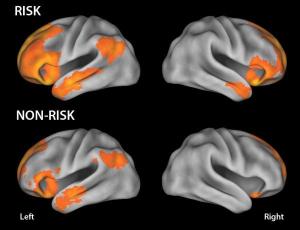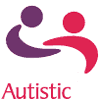ScienceDaily (Nov. 3, 2010) — Many gene variants have been linked to autism, but how do these subtle changes alter the brain, and ultimately, behavior?
Using a blend of brain imaging and genetic detective work, scientists at UCLA's David Geffen School of Medicine and Semel Institute for Neuroscience and Human Behavior are the first to illustrate how genetic variants rewire the brain. Published in the Nov. 3 online edition of Science Translational Medicine, their discovery offers the crucial missing physical evidence that links altered genes to modified brain function and learning.

Communication patterns in brain. In the top row, the brains of children carrying the risk version of CNTNAP2 show over-connectivity in the frontal lobe, with more connections to the right side of the brain (at left), compared with the brains (bottom row) of children whose DNA carries the non-risk version of the gene. (Credit: Ashley Scott-Van Zeeland)
"This is a key piece of the puzzle we've been searching for," said co-principal investigator Dr. Daniel Geschwind, a professor of neurology and psychiatry who holds UCLA's Gordon and Virginia MacDonald Distinguished Chair in Human Genetics. "Now we can begin to unravel the mystery of how genes rearrange the brain's circuitry not only in autism, but in many related neurological disorders."
The UCLA team scrutinized the differences in brain connectivity and function that result from two forms of the CNTNAP2 gene, one of which boosts risk for autism.
Earlier studies by Geschwind and others demonstrated that the gene is most active during brain development in the frontal lobe. The region is highly involved in learning, which is often disrupted in autistic children.
Suspecting that CNTNAP2 might influence brain activity, the researchers used functional magnetic resonance imaging (fMRI) to scan the brains of 32 children as they performed learning-related tasks. Half of the children had autism, and half did not.
The team's goal was to measure the strength of various communication pathways in different regions of the brain as they connected with each other.
The fMRI images excited the scientists -- and confirmed their suspicions.
Regardless of their diagnosis, the children carrying the risk variant showed a disjointed brain. The frontal lobe was over-connected to itself and poorly connected to the rest of the brain. Communication with the back of the brain was particularly diminished.
"In children who carry the risk gene, the front of the brain appears to talk mostly with itself," explained first author Ashley Scott-Van Zeeland, now a Dickinson Research Fellow at Scripps Translational Science Institute. "It doesn't communicate as much with other parts of the brain and lacks long-range connections to the back of the brain."
Depending on which CNTNAP2 version the child carried, the researchers also observed a difference in connectivity between the left and right sides of the brain. In most people, the left side processes functions tied to language, like speech and understanding.
In the children with the non-risk gene, communication pathways in the frontal lobe linked more strongly to the left side of the brain.
In children with the risk variant, communications pathways in the front lobe connected more broadly to both sides of the brain. The unusual symmetry suggests that the gene variant rewires connections in the brain, perhaps explaining why this version of CNTNAP2 is associated with delayed speech.
"We saw that if you had the risk variant, your brain showed disrupted activation patterns whether you were diagnosed on the autism spectrum or not," explained co-principal investigator Susan Bookheimer, a professor of psychiatry who holds the Joaquin Fuster Chair in Cognitive Neurosciences. "We suspect that CNTNAP2 plays an important role in wiring neurons at the front of the brain, and that the risk variant interferes with that process."
By enhancing understanding of the relationship between genes, the brain and behavior, the UCLA finding could lead to earlier detection for autism, and new interventions to strengthen connections between the frontal lobe and left side of the brain.
"If we determine that the CNTNAP2 variant is a consistent predictor of language difficulties," said Scott-Van Zeeland, "we could begin to design targeted therapies to help rebalance the brain and move it toward a path of more normal development."
Researchers could test whether specific therapies actually change brain function by measuring connectivity of patients before and after therapy, she added.
The authors emphasized that the patterns of connectivity found in the study still fall along the spectrum of normal gene variation. "One third of the population carries this variant in its DNA," noted Geschwind. "It's important to remember that the gene variant alone doesn't cause autism, it just increases risk."
Led by the UCLA Autism Center of Excellence, the research was supported by grants from the National Institute of Child Health and Human Development, National Alliance for Autism Research, National Center for Research Resources, Autism Speaks, Whitehall Foundation, Training Program in Neurobehavioral Genetics and a National Research Service Award.
Other UCLA coauthors included Ana Alvarez-Retuerto, Lisa Sonnenblick, Jeffrey Rudie, Dara Ghahremani, Jeanette Mumford, Russell Poldrack, Mirella Dapretto and Brett Abrahams, now at Albert Einstein College of Medicine.
Editor's Note: This article is not intended to provide medical advice, diagnosis or treatment.
Story Source:
The above story is reprinted (with editorial adaptations by ScienceDaily staff) from materials provided by University of California - Los Angeles. The original article was written by Elaine Schmidt.
Journal Reference:
A. A. Scott-Van Zeeland, B. S. Abrahams, A. I. Alvarez-Retuerto, L. I. Sonnenblick, J. D. Rudie, D. Ghahremani, J. A. Mumford, R. A. Poldrack, M. Dapretto, D. H. Geschwind, S. Y. Bookheimer. Altered Functional Connectivity in Frontal Lobe Circuits Is Associated with Variation in the Autism Risk Gene CNTNAP2. Science Translational Medicine, 2010; 2 (56): 56ra80 DOI: 10.1126/scitranslmed.3001344
www.psychspace.com心理学空间网

